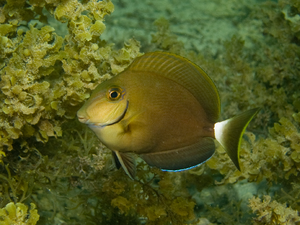Ocean surgeonfish
| Ocean surgeonfish | ||||||||||||
|---|---|---|---|---|---|---|---|---|---|---|---|---|

A young ocean surgeonfish |
||||||||||||
| Systematics | ||||||||||||
|
||||||||||||
| Scientific name | ||||||||||||
| Acanthurus bahianus | ||||||||||||
| Castelnau , 1855 |
The ocean surgeonfish ( Acanthurus bahianus ) is a kind from the family of surgeonfish and comes in western and central Atlantic before. Investigations of the mitochondrial DNA revealed a division of the Caribbean and Brazilian populations into two separate species. The Caribbean population is now called Acanthurus tractus and also differs in characteristic colorations.
features
The body is oval and its mouth is small and low down on the head. The tip of the mouth forms a small beak that has just the right curve to ideally eat algae from rocks and corals. Usually a specimen with a body length of 17 centimeters has 14 teeth in the upper and 16 in the lower jaw. The caudal fin is relatively long and has no notch. On both sides of the tail stalk there are scalpel-like elevations of the spine which can be used as a defense mechanism against enemies with the help of quick, sudden movements. This can also be dangerous for humans, and painful wounds can result if touched. The scales are small and have comb scales . The diurnal ocean surgeonfish reaches its largest body length of approx. 30.5 centimeters at the age of 4 years. The tallest individual ever reported was 37 centimeters long. At the age of 9 to 12 months, these fish reach sexual maturity with a body length of 11 to 13 centimeters. The median maximum age varies between 5 years in Jamaica and up to 26 years in Bermuda, up to a maximum of 32 years.
| Dispersion area | Maximum age (in years) |
|---|---|
| St. Helena , South Atlantic | 31 |
| Ascension , South Atlantic | 19th |
It is yellowish to grayish-brown and marked with very pale green-gray to pale blue vertical stripes. In addition, short yellow lines can be found running from the back of the eyes. The dorsal fin has a blue border and alternating orange or blue-green stripes. The anal fin is similarly colored. The caudal fin is olive to brown and shimmers white or bluish. Color changes may occur during the spawning season. The coloring serves the mating behavior and is supposed to have an effect on the females. Male competitors can also be impressed in intraspecific competitions. The dorsal fin has 9 hard and 23 to 26 soft rays, the anal fin 3 hard and 21 to 23 soft.
Distribution and habitat
This fish is found in the western Atlantic. The range begins on the coast of Brazil and is limited in the east by the island of St. Helena . Finds also report an occurrence on the coast of the Seychelles , but it is believed that this is an error.
The ocean surgeonfish inhabits coral reefs and rocky coastal areas with sand deposits. Typically occurs in groups of five or more individuals.
Way of life
During the day, these fish eat mainly green and brown algae as well as small amounts of invertebrates. Through their specially shaped mouth, they eat algae mats from corals and sand. When eating, a lot of sand is also ingested, this is supposed to help digestion. There can be 5 to 80% inorganic matter in its digestive tract.
Spawning takes place from November to April with the peak season from December to March. This usually takes place in very large groups, where the color of the fish themselves also changes. The eggs are spherical with a single oil ball in which the yolk sac of the fish larva is located. Each egg measures 0.17 millimeters in diameter. After hatching, the larvae have a body shape that is reminiscent of dragons due to the elongated snout. They are mostly eaten by large fish, especially tuna . They usually enter the juvenile stage at a length of around 23 to 33 mm and an age of 42 to 68 days, and as juvenile fish they retreat to reef and seagrass habitats.
Larger fish are potential predators of the ocean surgeon fish. Documented predators include Lutjanus analis , groupers , West Atlantic trumpet fish and the great barracuda .
Danger
The majority of these species spend their entire lives in coral reefs, which is also very endangered. A number of different factors, including climate change , are causing the corals to die and the quality of the habitat to deteriorate. Approximately 80% of all adult specimens of the ocean surgeonfish are affected by this problem.
supporting documents
- ↑ a b c d e f g Acanthurus bahianus in the IUCN 2017-3 Red List of Threatened Species . Posted by: Choat, JH, Abesamis, R., Clements, KD, McIlwain, J., Myers, R., Nanola, C., Rocha, LA, Russell, B. & Stockwell, B., 2010-05-03 .
- ↑ a b c d e f g h Cathleen Bester: OCEAN SURGEON. Florida Museum of Natural History, accessed March 23, 2018 .
- ↑ a b c Ocean Doctorfish on Fishbase.org (English)